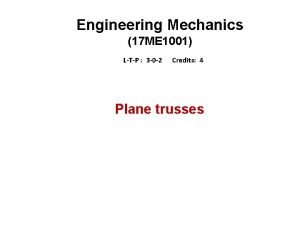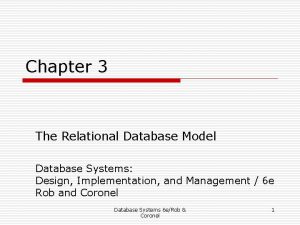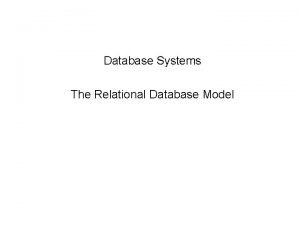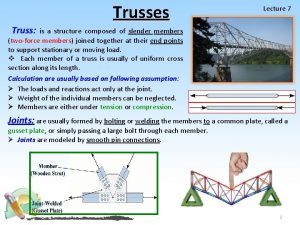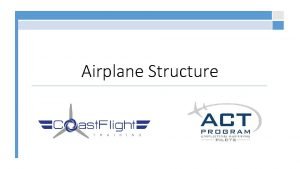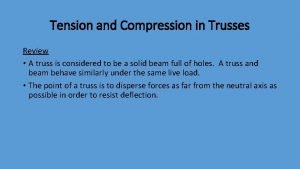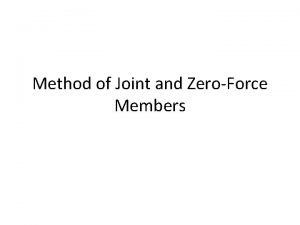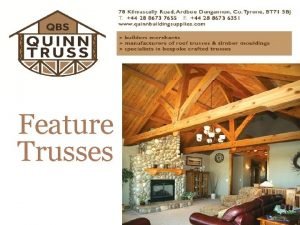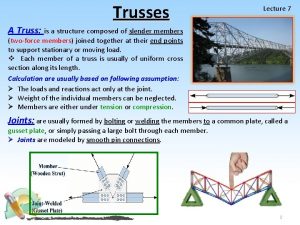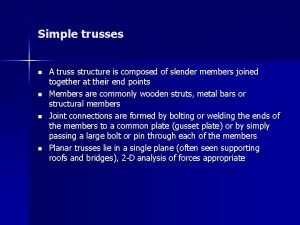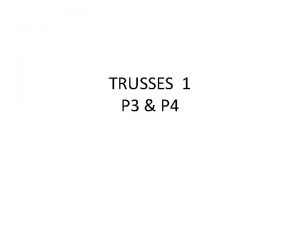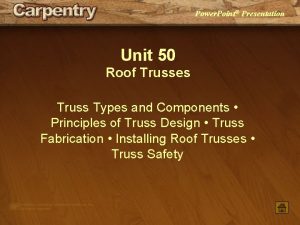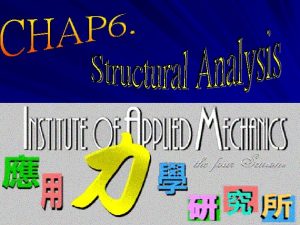Trusses Lecture 7 Truss is a structure composed










- Slides: 10

Trusses Lecture 7 Truss: is a structure composed of slender members (two-force members) joined together at their end points to support stationary or moving load. v Each member of a truss is usually of uniform cross section along its length. Calculation are usually based on following assumption: Ø The loads and reactions act only at the joint. Ø Weight of the individual members can be neglected. Ø Members are either under tension or compression. Joints: are usually formed by bolting or welding the members to a common plate, called a gusset plate, or simply passing a large bolt through each member. Ø Joints are modeled by smooth pin connections. 1

Analysis of Trusses Lecture 7 Truss Analysis Internal equilibrium External equilibrium To find the force in each member To find the reaction forces Method of joints Method of sections External Equilibrium: to find the reaction forces, follow the below steps: 1. Draw the FBD for the entire truss system. 2. Determine the reactions. Using the equations of (2 D) which states: 2

Analysis of Trusses Lecture 7 Method of Joints: to find the forces in any member, choose a joint, to which that member is connected, and follow the below steps: 1. Draw the FBD for the entire truss system. 2. Determine the reactions. Using equations of (2 D) which states: the 3. Choose the joint, and draw FBD of a joint with at least one known force and at most two unknown forces. 4. Using the equation of (2 D) which states: 5. The internal forces are determined. 6. Choose another joint. 3

Analysis of Trusses Lecture 7 Method of section (Internal equilibrium): to find the forces in any member, choose a section, to which that member is appeared as an internal force, and follow the below steps: 1. Draw the FBD for the entire truss system. 2. Determine the reactions. Using equations of (2 D) which states: the 3. Choose the section, and draw FBD of that section, shows how the forces replace the sectioned members. 4. Using the equation of (2 D) which states: 5. The internal forces are determined. 6. Choose another section or joint. 4

Analysis of Trusses Lecture 7 Analysis of trusses (Zero-force members): Analysis of trusses system is simplified if one can identify those members that support no loads. We call these zero-force members. Examples to follow: 1. If two members form a truss joint and there is no external load or support reaction at that joint then those members are zero-force members. Joints D and A in the following figure are the joints with no external load or support reaction, so: FAF = FAB = FDE = FDC = 0. 5

Analysis of Trusses Lecture 7 Analysis of trusses (Zero-force members): Examples to follow: 2. If three members form a truss joint and there is no external load or support reaction at that joint and two of those members are collinear then the third member is a zero-force member. In the following figure, AC and AD are zero-force members, because Joints D and A in the following figure are the joints with three members, there is no external load or support reaction, so: FCA = FDA = 0 6

EXAMPLES of Trusses: Lecture 7 Example 1: Determine the support reactions in the joints of the following truss. Calculate the force in member (BA & BC. ) Solution 1. Draw FBD of entire truss and solve for support reactions: 2. Draw FBD of a joint with at least one known force and at most two unknown forces. We choose joint B. Ø Assume BC is in compression. 7

Lecture 7 EXAMPLES of Trusses: Example 2: In the following Bowstring Truss, find the force in member (CF). Solution draw the FBD and find the support reactions which are shown below å Fy = 0 å MA = 0 RE * 16 – 5 * 8 – 3 * 12 = 0 RE + RA – 5– 3 = 0 RE = 4. 75 k. N RA = 3. 25 k. N G F 2 m 6 m C D 4 m O E 4 m X 8

EXAMPLES of Trusses: Lecture 7 Example 3: In the following truss, find the force in member (EB). Solution Notice that no single cut will provide the answer. Hence, it is best to consider section (a-a and b-b). å MA = 0 RC * 8 – 1000 * 6 – 1000 * 4 – 3000 * 2 = 0 RC = 2000 N å Fy = 0 RA + RC – 1000 – 3000 - 1000 = 0 RA = 4000 N Taking the moment about joint (B), to find (FED), as shown in below figure: åMB = 0 1000 * 4 + 3000 * 2 – 4000 * 4 + FED * sin 30 o * 4 = 0 FED = 3000 N (compression) 9

Lecture 7 Continue Example 3: From joint (E) to find (FEB), as shown in below figure: å Fx = 0 FEF. cos 30 o– 3000 cos 30 o = 0 FEF = 3000 N (compression) å Fy = 0 FEF. Sin 30 o + 3000. sin 30 o - 1000 - FEB = 0 FEF = 2000 N (Tension) 10
 L-shaped roof truss layout
L-shaped roof truss layout Plane truss and space truss
Plane truss and space truss 01:640:244 lecture notes - lecture 15: plat, idah, farad
01:640:244 lecture notes - lecture 15: plat, idah, farad Two-dimensional structure composed of rows and columns
Two-dimensional structure composed of rows and columns Two-dimensional structure composed of rows and columns
Two-dimensional structure composed of rows and columns Bowstring truss analysis
Bowstring truss analysis Open truss structure
Open truss structure Truss tension compression
Truss tension compression Unstable truss example
Unstable truss example Zeroforce
Zeroforce Feature trusses
Feature trusses

